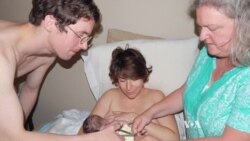A small but growing number of women in the United States are choosing to give birth using the services of a certified nurse-midwife rather than an obstetrician. The number of midwife-attended births - at home, in birthing centers and in hospitals - reached 8.6% of all births in 2012.
Beth Drake of Derwood, Maryland is one of those statistics. She recently gave birth to baby Debra with the help of a certified nurse-midwife in the comfort of her own home.
The first-time mother decided on a home birth after witnessing her sister give birth in a hospital.
“To see the baby taken away from her right away and placed on the table - he was warmed and fully taken care of - but he was crying and alone; it just didn’t seem as gentle a way to come into the world as I wanted for my child,” she said.
So for her own pregnancy and labor, Drake and her husband Derek chose Mairi Breen Rothman, a certified nurse-midwife who’s been delivering babies since 1996.
Drake said having Rothman there for the hardest parts of her labor was very reassuring. “Mairi would suggest changing positions and would be there to rub my back and I think that was the most surprising thing for me about the whole experience was how present she really was with me the whole time.”
And her delivery was a memorable birthing experience.
“As soon as the baby came out, she was immediately placed on my chest,” she said. “So I got to say hello to my baby right away, and Derek was right there so he was the second person that she would have seen. It was really, really special to have all of the intensity gone and this new part of life started in such a gentle way.”
'Not just for hippies'
Certified nurse-midwives are nurses who receive specialized training in obstetrics, labor and delivery. They generally work with low-risk pregnancies, and are required to have a plan for consultation, collaboration and referral with other levels of medical care should things become complicated.
“I have this poster that says ‘home birth; it’s not just for hippies anymore,’” noted Rothman with a smile, “because women from every walk of life choose to have their babies at home.”
The numbers are growing, even though midwives have often had to struggle with negative stereotyping.
Opponents of home birth cite studies that claim a higher risk of neo-natal deaths due to the distance a patient would have to travel to get to a medical facility in case an emergency develops. But Rothman said these studies are "not based on science and are the subject of great controversy in the birth community."
“Midwives have fought for legitimacy for many decades, so as a result they’ve become extra competent, extra vigilant, and very much specialists in the care of women experiencing normal childbirth and normal pregnancy.”
She notes that in many countries in the world - many of them with much better infant mortality rates that the U.S. - midwifery care is the portal of entry into the maternity care system.
“Everyone starts with a midwife,” she explained, “and they only move to a more specialized form of care if it’s indicated by their personal health. But in the vast majority of cases you don’t need medical care, you just need maternal health care during your pregnancy.”
She points to the Netherlands, which has some of the best outcome data of anywhere in the world in terms of maternal infant and infant mortality, where a third of the babies are born at home.
An integrated system
Concerns about the safety of using a midwife are unfounded, agrees Eugene Declercq, Professor and Assistant Dean of Community Health Sciences at Boston University School of Public Health.
“The evidence suggests that an integrated system where midwives do what’s often called primary care - first line care - for mothers is every bit as safe as a system based entirely on having high-risk specialists do all the births.”
That approach is summed up by a phrase used in England: ‘all mothers deserve a midwife and some mothers need an obstetrician too.’ "I think that describes to me what would be an ideal system; that care starts with midwives but that they work in conjunction with obstetricians around cases that may require risk and may require more specific medical intervention.”
According to Declercq, that sort of cooperative approach offers safety at a lower cost. “The impact of that in the long run would be less intervention in our system and most importantly, intervention only when it’s necessary.”
The larger point, he said, is to have an integrated system “where midwives and obstetricians are working together and not at odds with each other.”
And that seems to be happening at a slow - but steady - rate. Many hospitals around the country are responding to women's interest in having a more natural birth experience by working more closely with midwives and are also setting up baby-friendly environments where mothers can keep their babies with them in a home-like setting and receive nutrition and breastfeeding support.
In the meantime, new mom Beth Drake encourages women who are thinking about their childbirth options to educate themselves about their choices so they can make the best decision for themselves - and their babies.










